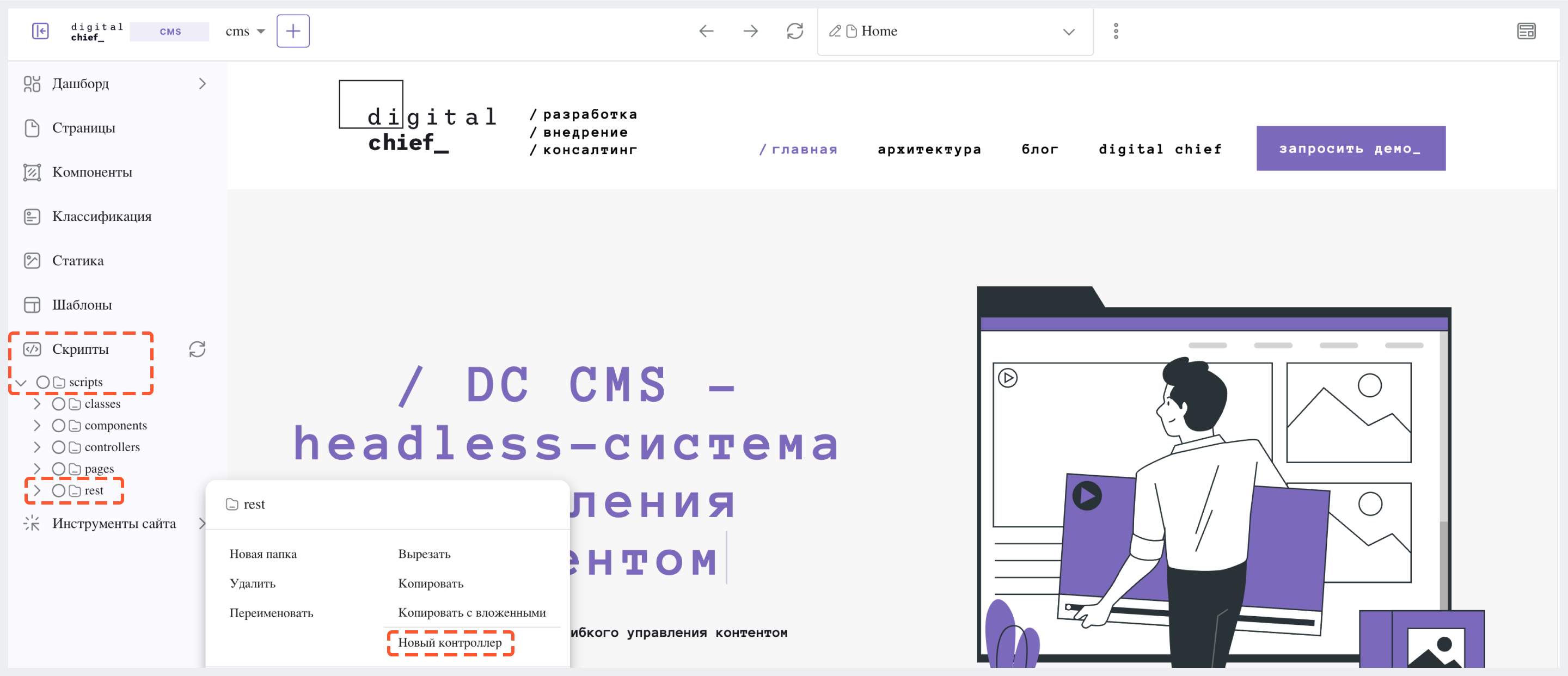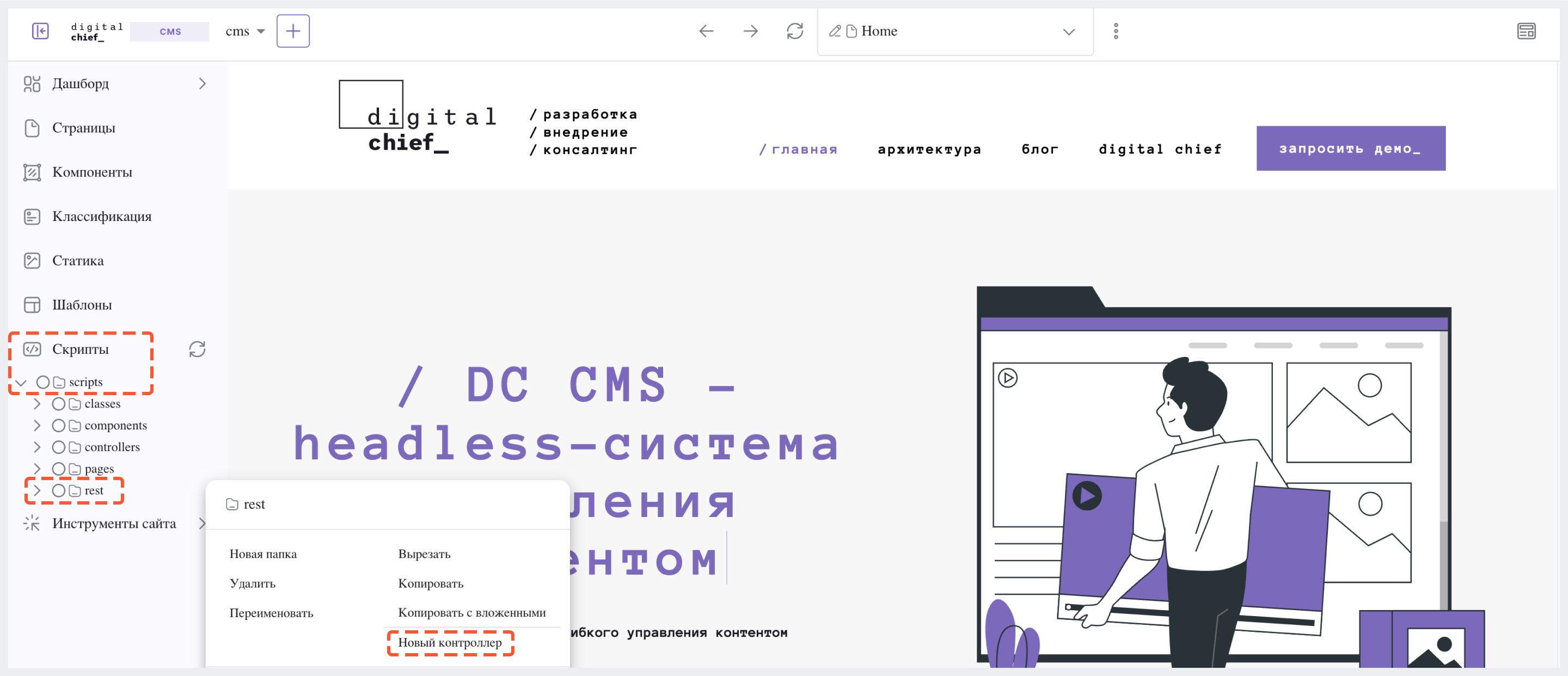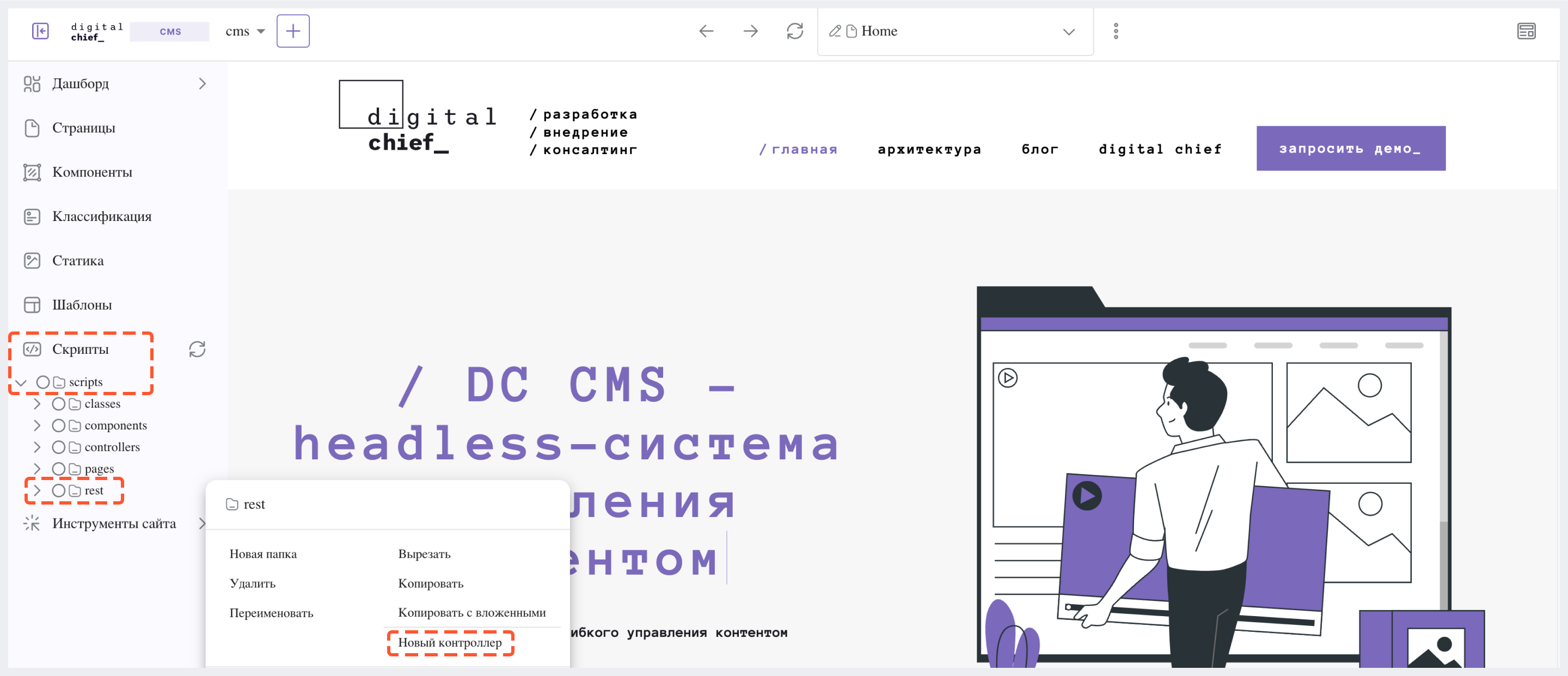API получения REST-контента
Чтобы получить доступ к контенту, вы можете использовать API для получения REST-контента.
Убедитесь, что запрос содержит параметр
dcSite, чтобы указать значение проекта. Поскольку API для получения контента настроены под конкретные проекты, необходимо предоставлять информацию о проекте при каждом запросе.
Вот пример получения элемента из хранилища контента:
http://localhost:8080/api/1/site/content_store/item.json?url=/site/website/index.xml&dcSite=mysite
Примеры
Ниже приведены несколько примеров создания RESTful сервисов в DC CMS.
Рендеринг компонентов страницы в формате JSON
Контент как сервис (CaaS) - широко используемая необходимость в современном многоканальном мире. Обычно варианты использования CaaS требуют, чтобы контент был лишен форматной разметки (presentation markup), чтобы клиент мог представить контент так, как он пожелает. Иногда клиенты также могут захотеть получить предварительно отрендеренный контент. Ниже представлен простой пример REST (один сценарий для контроллера REST на основе Groovy), который предлагает метод отображения всех компонентов, связанных с страницей.
Шаг 1: Создание REST контроллера
1. В боковой панели перейдите в раздел Скрипты > scripts > rest, щелкните правой кнопкой мыши и выберите Новый контроллер.

2. Введите get-rendered-components.get в качестве имени контроллера.
3. Добавьте этот код в контроллер:
import java.io.ByteArrayOutputStream
import java.io.IOException
import java.io.PrintWriter
import javax.servlet.Filter
import javax.servlet.FilterChain
import javax.servlet.FilterConfig
import javax.servlet.ServletException
import javax.servlet.ServletOutputStream
import javax.servlet.ServletRequest
import javax.servlet.ServletResponse
import javax.servlet.http.HttpServletRequest
import javax.servlet.http.HttpServletResponse
import javax.servlet.http.HttpServletResponseWrapper
import javax.servlet.WriteListener
import groovy.util.XmlSlurper
def result = [:]
def targetPage = params.pageId
if (targetPage != null) {
result.page = targetPage
def pageItem = siteItemService.getSiteItem(targetPage)
if (pageItem != null) {
def componentPaths = pageItem.queryValues("//include")
result.components = []
if (componentPaths != null) {
componentPaths.each { componentPath ->
if (componentPath.endsWith(".xml") && !componentPath.startsWith("/site/website") ) {
logger.info("Including component ${componentPath} into JSON response")
def component = [:]
component.id = componentPath
// wrap the response to capture the output
def wrappedResponse = new CapturingResponseWrapper(response)
// "include" the page that does the actual work
request.getRequestDispatcher("/dc-controller/component?path=" + componentPath).include(request, wrappedResponse)
// get the captured output, parse it and prepare the actual response
def capturedOut = wrappedResponse.getCaptureAsString()
component.markup = capturedOut
result.components.add(component)
}
}
} else {
result.message = "No components found"
}
} else {
result.message = "Page '${targetPage}` not found"
}
} else {
result.message = "Parameter pageId is required."
}
return result
protected class CapturingResponseWrapper extends HttpServletResponseWrapper {
private final ByteArrayOutputStream capture
private ServletOutputStream output
private PrintWriter writer
public CapturingResponseWrapper(HttpServletResponse response) {
super(response)
capture = new ByteArrayOutputStream(response.getBufferSize())
}
@Override
public ServletOutputStream getOutputStream() {
if (writer != null) {
throw new IllegalStateException("getWriter() has already been called on this response.")
}
if (output == null) {
output = new ServletOutputStream() {
@Override
public void write(int b) throws IOException {
capture.write(b)
}
@Override
public void flush() throws IOException {
capture.flush()
}
@Override
public void close() throws IOException {
capture.close()
}
@Override
public void setWriteListener(WriteListener writeListener) {
}
@Override
public boolean isReady() {
return true
}
}
}
return output
}
@Override
public PrintWriter getWriter() throws IOException {
if (output != null) {
throw new IllegalStateException("getOutputStream() has already been called on this response.")
}
if (writer == null) {
writer = new PrintWriter(new OutputStreamWriter(capture, getCharacterEncoding()))
}
return writer
}
@Override
public void flushBuffer() throws IOException {
super.flushBuffer()
if (writer != null) {
writer.flush()
}
else if (output != null) {
output.flush()
}
}
public byte[] getCaptureAsBytes() throws IOException {
if (writer != null) {
writer.close()
}
else if (output != null) {
output.close()
}
return capture.toByteArray()
}
public String getCaptureAsString() throws IOException {
return new String(getCaptureAsBytes(), getCharacterEncoding())
}
}
Шаг 2: Выполнение сервиса
Откройте браузер и перейдите по следующему URL-адресу: http://localhost:8080/api/1/services/get-rendered-components.json?pageId=/site/website/index.xml
Получение названий сайтов, запущенных в CMS Engine
В этом примере мы создадим простой RESTful сервис, который возвращает список сайтов, запущенных в CMS Engine.
Шаг 1: Создание REST контроллера
1. В боковой панели перейдите в раздел Скрипты > scripts > rest, щелкните правой кнопкой мыши и выберите Новый контроллер.

2. Введите get-sites.get в качестве имени контроллера.
3. Добавьте этот код в контроллер:
def siteContextManager = applicationContext["dc.siteContextManager"]
def siteContextList = siteContextManager.listContexts()
def siteNames = []
siteContextList.each { siteContext ->
def name = siteContext.getSiteName()
siteNames.add(name)
}
return siteNames
Шаг 2: Выполнение сервиса
Откройте браузер и перейдите по следующему URL-адресу: http://localhost:8080/api/1/services/get-sites.json
Получение страниц для сайта
В этом примере мы создадим простой RESTful сервис, который возвращает список страниц на сайте. Сервис параметризован, чтобы позволить вызывающему установить начальную точку и глубину.
Шаг 1: Создание REST контроллера
1. В боковой панели перейдите в раздел Скрипты > scripts > rest, щелкните правой кнопкой мыши и выберите Новый контроллер.

2. Введите get-pages.get в качестве имени контроллера.
3. Добавьте этот код в контроллер:
def pathParam = (params.path != null) ? params.path : ""
def depthParam = (params.depth != null) ? params.depth.toInteger() : 0
def path = "/site/website" + pathParam
def depth = depthParam != 0 ? depthParam : 2
def navItems = [:]
def siteDir = siteItemService.getSiteTree(path, depth)
if(siteDir) {
def dirs = siteDir.childItems
dirs.each { dir ->
def dirName = dir.getStoreName()
def dirItem = siteItemService.getSiteItem("/site/website/${dirName}/index.xml")
if (dirItem != null) {
def dirDisplayName = dirItem.queryValue('internal-name')
navItems.put(dirName, dirDisplayName)
}
}
}
return navItems
Шаг 2: Выполнение сервиса
Откройте браузер и перейдите по следующему URL-адресу: http://localhost:8080/api/1/services/get-pages.json



